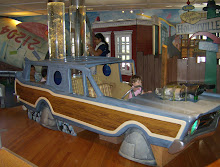“Things have been going pretty well at our museum, so we started thinking how we could leverage our strength to improve our neighborhood.”
For me, that was a big WOW. Maybe I need to get out more, but that’s the first time I’ve heard that kind of talk from any other children’s museum (other than using educational programs as outreach and social service). She mentioned interesting ideas like covering the local highway underpass with art, and stimulating connections between the various parks and cultural attractions in her area through the Charm Bracelet project. Since my motivations for starting Kidcity were more about quality of life in our community than about education, this was right up my alley.
As Kidcity’s director, I spend a significant amount of time working on Middletown. Although I can’t say I planned it this way, I find that my focus on the community helps the museum in two ways: first, there is a direct relationship between Kidcity’s appeal and the quality of our town – as Middletown goes up or down, so goes our draw as a destination. Second, my work builds social capital for Kidcity, and I know that we owe our existence and growth more to social capital than to financial capital. Social capital builds when you contribute to the life of the community (I love Robert Putnam’s book “Bowling Alone” for a very persuasive argument on this topic). Briefly put, having social capital means that when you want to get things done, the credibility and friendships you have developed are just like money in the bank. As an additional bonus, it’s fun.
So what does "Building Social Capital" mean on a daily basis? That would be different for everyone, but here are some of the things that I've been working on in the past year or so in our little town of 42,000 souls (other than my administrative and design work at the museum):
•helping establish "Creative Juice", a council for people in the arts and creative industries at our local chamber of commerce, co-chairing the first year;
•chairing the Downtown Business District (now 8 years old). The DBD is a group of 140 Main Street businesses that agreed to tax ourselves. I helped write our operating plan, which starts with the principle that Middletown has to be "clean, safe, and civil" before businesses can thrive -- we run a variety of maintenance, beautification projects, as well as providing strolling downtown guides.
•writing about city meetings and other stuff for a new hyper-local news blog, www.middletowneyenews.blogspot.com, which began in response to the decline of our local newspapers.
•being active on a 15-month study of the parking in our downtown, and lobbying for a new municipal department to manage it all.
•trying - and mostly failing - to find a resolution to the onslaught of graffiti around town, hopefully including a managable system for reporting and quick clean-up.
•helping various local non-profits with fundraising (sometimes at Kidcity and sometimes independently) and being active in the PTA of the Title 1 school in our neighborhood, where my 1st grader is a student.
•going to stuff! Supporting the dances, performances, meetings, potlucks and instigations of my neighbors.
 Over the next few months I expect to be working on the design of a grant-funded wayfinding system (our downtown signage is truly awful - here's a photo of the excellent wayfinding system I saw in Philadelphia) and starting a dialogue with other arts/entertainment venues to talk about a possible joint branding and promotion campaign. I'd love to hear more people in the children's museum field talk about ways that they are connecting to others throughout the community, not just in direct partnerships, but in ways that "leverage the strength" of the children's museum to help the community in diverse ways.
Over the next few months I expect to be working on the design of a grant-funded wayfinding system (our downtown signage is truly awful - here's a photo of the excellent wayfinding system I saw in Philadelphia) and starting a dialogue with other arts/entertainment venues to talk about a possible joint branding and promotion campaign. I'd love to hear more people in the children's museum field talk about ways that they are connecting to others throughout the community, not just in direct partnerships, but in ways that "leverage the strength" of the children's museum to help the community in diverse ways.
